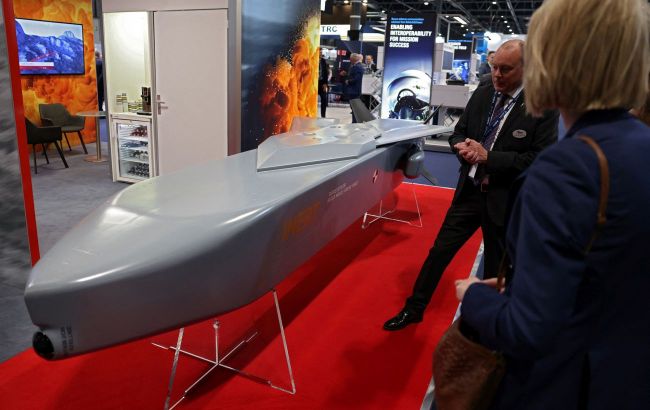What missiles can the West provide to Ukraine, and why not like Shaheds?
 Photo: USA and Europe still have missiles that they can provide to Ukraine for the war (GettyImages)
Photo: USA and Europe still have missiles that they can provide to Ukraine for the war (GettyImages)
Ivan Kyrychevskyi, an expert from the Defense Express Media and Consulting Company shared his insights on the long-range weapons that the USA and Europe can provide to Ukraine, and why they are not transferring them, in a column for RBC-Ukraine.
Why does Ukraine request long-range weaponry of Western, rather than Soviet, design? Because the nomenclature that could still be present in the countries of the former Warsaw Pact, in Eastern Europe, is at most the Tochka-U (with a range of 120 kilometers). It's unclear in what condition they are. Whether we have received such missiles is also unknown. However, during a series of strikes in the summer of this year on the temporarily occupied Berdyansk, the Russians claimed that Tochka-U was hitting them. So, somehow, we had maintained a supply of these missiles, possibly not solely from internal resources.
Speaking of aviation missiles of Soviet design, both we and our Eastern European neighbors had problems with them. Until 2010, we still had around a hundred old Soviet Kh-59 missiles with a firing range of 45-110 kilometers, but they were written off. By the way, these missiles were used by the Russians to attack Ukrainian oil depots in the spring of 2022, so they are quite potent weapons.
Our partners, including Poland and Slovakia, did not have long-range guided missiles suitable for Soviet aircraft. Therefore, they tried to provide us with large-caliber rocket projectiles, such as the S-25, which can reach targets several kilometers away and are designed to destroy particularly large objects like railway stations. There was an incident last year when rockets with the inscription "Za Vinnytsiu" ("For Vinnytsia") were used in response to Russian actions, and it was assumed they were delivered from Poland.
From various photographs and open sources, it can also be concluded that we had a certain stock of Kh-25-type missiles, but their launch range is limited to 10 kilometers. Such missiles were used with our Su-24 aircraft.
For these reasons, we have to request Western missiles and, if possible, adapt them to Soviet aircraft, which they are not designed for according to the instructions. If we consider samples of aviation-based weaponry that have not been transferred to us yet, it includes the German Taurus air-launched cruise missile (there's also a version for ground launch, but the question is whether it's in serial production), AGM-158, or SLAM-R for F-16 (developed based on Harpoon for ground targets at distances of up to 300 kilometers).
Storm Shadow and SCALP, which our partners have already supplied, are two types of long-range air-launched missiles that are most common in Europe. Spain has several dozen Taurus missiles, but they still need Germany's permission for transfer. As for Taurus, there is another question - what to launch them from. The Swedish Gripen could be the standard carrier for Taurus. However, it seems that the prospects of receiving these fighters are even further off than Taurus. And F-16s, which our allies have agreed to transfer to us, doctrinally are not carriers of these German missiles.
Interesting fact: Taurus, Storm Shadow, and SCALP were developed as part of a unified European project called Apache back in the 1980s. Europeans didn't want to buy cruise missiles from the USA and instead decided to develop their own.
In addition, the French have sea-based SCALP cruise missiles with a range of 900 kilometers, but we don't have ships for such missiles, so this option is not available to us.
According to information from open sources, up to a thousand Storm Shadow missiles were manufactured in total. However, some of them were used in campaigns in Libya, and Syria, and some were sold to Saudi Arabia. SCALP missiles were produced in a quantity of about 600 units. The French press reported that as of the beginning of 2023, there were approximately 400 units, as any missile has a specified service life. So when the Germans say they have a total of 600 Taurus missiles in stock but only 150 of them are ready for combat, this could very well be true.
Speaking of ground-based missiles, we request ATACMS from the US, which can be launched from HIMARS. Why these missiles? Because other countries - France, Germany, and the UK - simply don't have their own ground-based missiles, as they didn't develop them. France, in the 1990s, completely wrote off its ground-based ballistic missiles.
This can be explained by the fact that until 2019, the Intermediate-Range Nuclear Forces Treaty was in formal effect. The treaty was in effect until the Russians built the Iskander-K with a range of 1,500 kilometers and small corvettes for the Kalibr missiles. Now, most missile carriers in the Russian fleet are small corvettes. These corvettes were another way to circumvent this INF Treaty, as such small corvettes could move along Russia's internal waterways, such as the Volga. Therefore, by 2023, Europe found itself in a state where its reserves of weapons were very limited.
Britain, France, and Germany focused only on developing air-launched missiles that fit within the 500-kilometer range. Not because they couldn't develop longer-range missiles, but seemingly because they didn't see the need. Storm Shadow and the Russian Kh-101, for example, are not significantly different in size.
The most likely reason we haven't received ATACMS yet is that there are very few of them - around 1,500 units. However, there could be another reason - they are very old. They have exceeded their standard service life. They need to be refurbished to be operational. But imagine if the Americans came out and said: 'Our ATACMS are very old, we are refurbishing them.' It would damage the prestige of the world's superpower. It's better to talk about escalation management to save face.
As for GLSDB, which has already been approved for transfer from the USA, it is a combination of the Small Diameter Bomb (SDB) GBU-39 with the rocket engine from the M26 rocket for HIMARS. Tests have shown that this is like a working concept. But they simply need to be made. Moreover, the targeting system needs to be perfected because GBU-39 itself is guided by a laser beam from an aircraft, while GLSDB is intended to be launched from a ground-based system like HIMARS. During the first year of deliveries, there was talk of several dozen per month, even though they were supposed to start delivering them only this fall. So, there is a real production problem with them.
When it comes to combat drones, Ukraine is literally ahead of the whole world, even if these Tu-141 Stryzh drones, which were produced back in Soviet times at the Kharkiv Aircraft Plant with a range of 1000 kilometers, look primitive. In reality, similar developments might only be in China. This spring, the United Kingdom announced that it plans to transfer to us a batch of kamikaze drones with a range of 200 kilometers, and at that time, it was seen as a long-awaited event. It's unclear what happened with that story, but in the meantime, we have produced our own analogs of Shaheds. Even the drone that flies to Moscow, under the conditional name Bober, according to its characteristics (as even the Russians themselves have acknowledged) is better than the Shahed-131,
It took Iran two decades to reach the technological level to develop the Shahed-136, and at least five years, from 2014 to 2019, to actually develop this drone. Before they started hitting Ukraine, it is believed that Iran used them against Israeli tankers, handed them over for strikes in Saudi Arabia, and even used them against American forces in Iraq. So, we are moving even faster than one can imagine.

